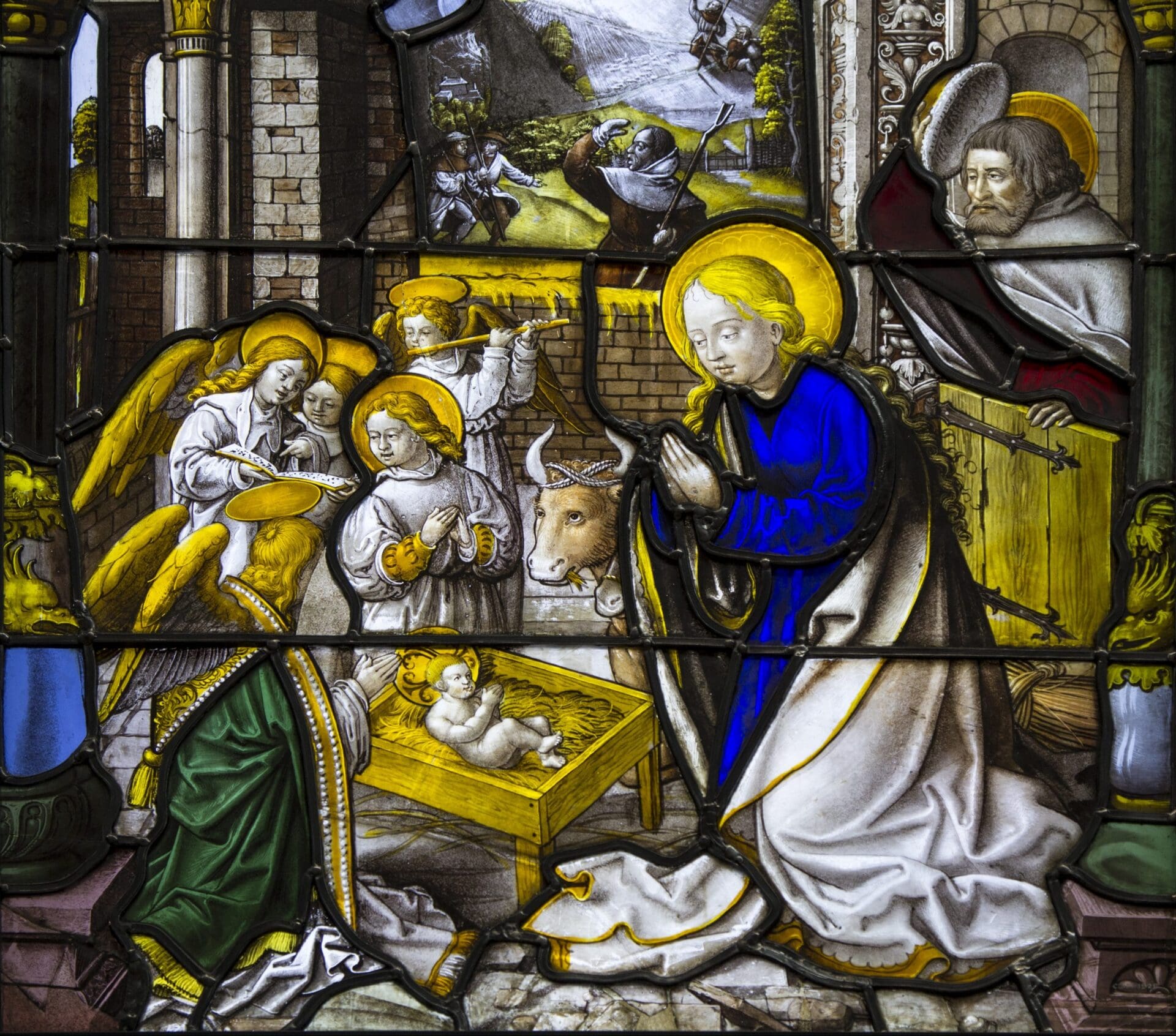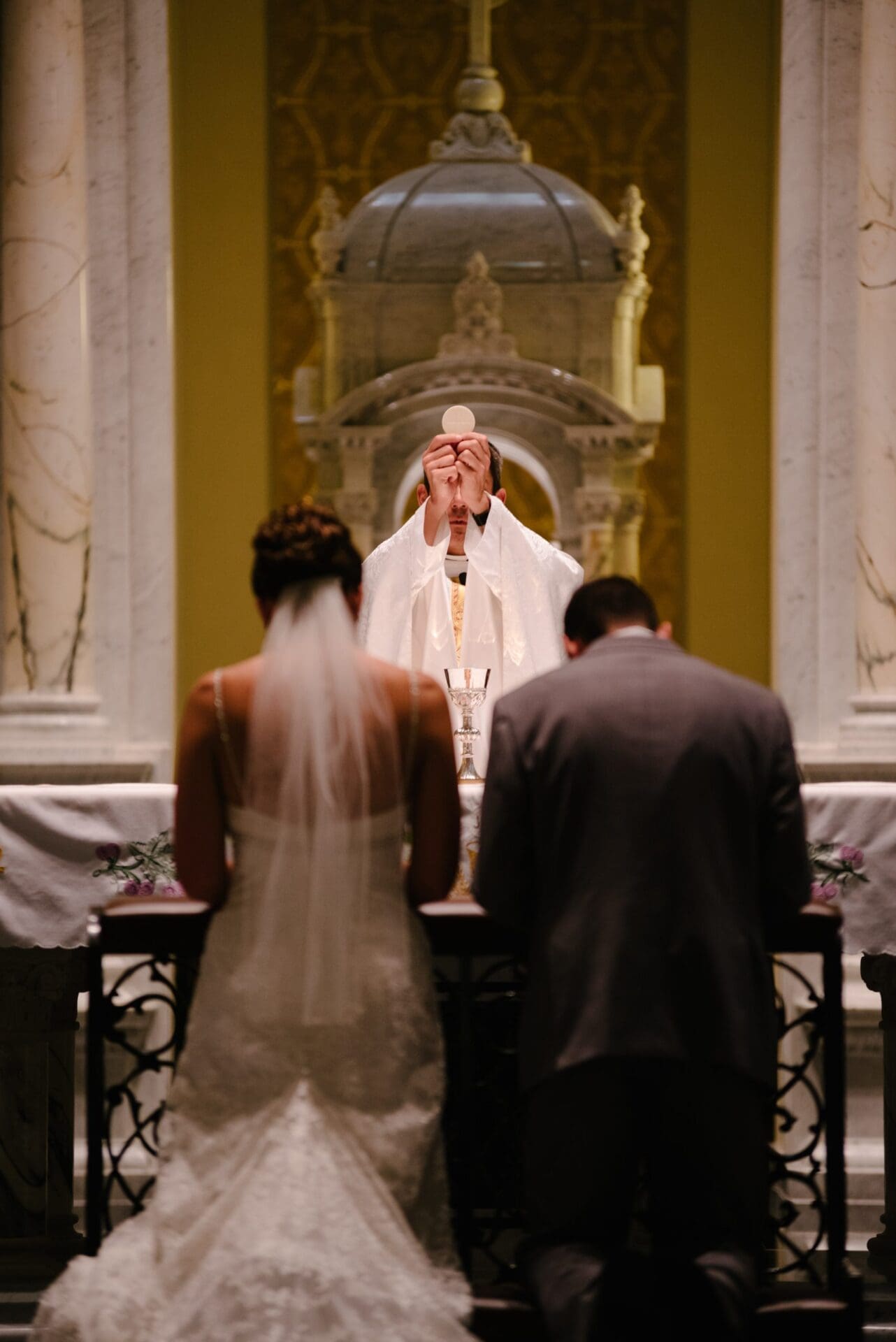For those who wait in joyful hope for the coming of the Feast of Corpus Christi each year, a storehouse of culture rooted in liturgy awaits rediscovery in the lost tradition of The York Plays. As late-medieval England’s most impressive example of cycle-drama, The York Cycle consisted of a series of more than forty-five sacred pageants (sacrae paginae) which began with The Fall of the Angels, continued through the major events of salvation history, and culminated with Doomsday. Each play survives in a single manuscript, a copy of the civic authority’s official record known as the Register, against which actors once checked their own scripts for accuracy.[1]
Although the Register’s compilation commenced between 1463 and 1477 and continued well into the 1500s, the history of the York Cycle’s performance ran for a century on either side of the initial compilation window. Beginning in 1376 and ending in 1579, for two full centuries the lay faithful in York worked closely with the civic and ecclesiastical authorities to perform The York Plays in honor of the Feast of Corpus Christi.
Role of a Lifetime
The sponsorship of each pageant in the cycle was assigned to one or more of the city’s craft guilds. Such assignments derived in some way from the mystery being depicted. To the shipwrights, for example, was given The Building of the Ark; to the fishers and mariners, The Flood; to the masons, Herod;[2] to the goldsmiths, The Magi; and to the nail-makers, The Crucifixion. Reflected in each play’s sponsorship was the individual and collective sanctification of human labor, a profound meditation on each one’s role in the drama of salvation.
The event of the Birth of Christ, for example, highlights the work of the tile-thatchers, the sponsors of The Nativity, by showing that without their work the stables of the inn would have offered no shelter to the Holy Family. The tile-thatchers, by analogy, thus become the ‘angels’ commonly depicted in medieval stained glass repairing the roof which shelters the Christ-child’s manger. By meditating on associations such as these, audiences were invited to contemplate their own work’s role in the drama of salvation.
Owing their essence and action to Christian liturgy, The York Plays refer the macrocosm of salvation history to the microcosm of its re-presentation in the Paschal Mystery. The cycle requires part-in-whole thinking: What part do the tile-thatchers play, for example, in Christ’s redemptive work? At pivotal moments throughout the cycle, this part-in-whole dynamic shows the ways in which human labor is ordered to lasting leisure, whose foretaste is liturgy. Relating the mysteries of salvation to the Eucharist, one narrative at a time, the full scope of the redemption is shown to be fulfilled at long last in sacred liturgy’s mystagogical re-presentation of God’s work of Redemption.
The Play’s the Thing
Joseph’s Trouble About Mary, sponsored by a guild which manufactured liturgical items such as thuribles, dramatizes Joseph’s difficulty in comprehending the Virgin-with-Child, the great mystery or sacramentum of Christ’s Body.[3] The wonder of Joseph becomes specifically Eucharistic in The Nativity when Mary welcomes the Christ-child with a litany used by the late-medieval lay faithful during the Elevation of the Host at Mass.[4] At the end of the play, Mary and Joseph lay the Christ-child in the manger while repeating together a vernacular version of the prayer prescribed for the priest’s quiet recitation in Latin (tacita voce) at the end of each Mass in accord with the rubrics of the York Missal.[5] The Nativity subtly shows that the Body of Christ, the Christ-child born in the stables at Bethlehem, is thus made present at every Mass, a miracle celebrated in sacred drama in York on Corpus Christi Day.
Christ’s Entry Into Jerusalem, a play co-sponsored by the vestment-makers, is strongly indebted to late-medieval Palm Sunday processions, which featured the Eucharist as the ritual’s source and summit.[6] It would not be a stretch to suppose that the kind of hymn sung during this pageant at the direction tunc cantant (‘then they sing’) may have echoed the Mass in general—Hosanna!—or the Triduum in particular, a liturgy which still today prescribes that the people chant Venite adoremus! The city officials, i.e., the burgesses, welcome Christ in the form of an elevation-prayer similar to the one used by Mary in The Nativity. Just as Mary welcomes the Christ-child at Bethlehem, so the city welcomes the great mystery of Christ’s Body, Corpus Christi, into York’s civic life and labor.
The post-Resurrection plays continue The York Cycle’s settled pattern of interlacing biblical narrative with liturgical allusion. Mary Magdalene, in a richly ironic dialogue with the Risen Lord, begs Jesus (appearing as a gardener) to lead her to her Lord. God in a garden with a woman whose faith is being tested: the scene itself highlights the typological structure of the cycle. “I see him not,” Mary laments. Jesus responds by showing her his wounds, a test of faith after which Mary declares her belief in a “miraculous food” which is “sweeter than wine”—the Body and Blood of Christ. The play, naturally, was sponsored by the wine-drawers.[7] In a magnificent imitation of liturgy through dramaturgy, The Supper at Emmaus depicts Jesus literally disappearing at the moment of the consecration. Christ’s apparent ‘disappearing act’ is not for mere show, either; in place of spectacle it offers a theatrical representation of the Church’s perennial teaching on transubstantiation. It’s not that Jesus disappears; rather, the bread at Emmaus becomes the Body and Blood of Christ.
One might wonder, though, Why depict transubstantiation at Emmaus rather than at The Last Supper?
The bakers’ Last Supper, featuring the apocryphal character Marcellus leading the disciples to the Lamb’s Supper, contains a curious lacuna: at the moment of the institution of the Eucharist, the manuscript is corrupt. Richard Beadle, the world’s leading textual-bibliographical scholar of The York Plays, suspects “deliberate removal” of this section of the play.[8] Such censure should not come as a surprise given the contentious circumstances in which The York Plays were suppressed.
Curtain Call
At the time of the Northern Uprising of 1569, an unsuccessful attempt by Catholic nobles in northern England to depose the Protestant Queen Elizabeth I, which was itself spurred by royal intolerance of Catholic devotion in the north, the Register containing The York Plays was summoned for review by the Queen’s Commission for Ecclesiastical Causes. Although given back at that time, the Register was summoned once again ten years later in 1579, this time never to be returned to the city’s civic authorities.
So ended this great popular devotion of the Christian people, which harmonized with the liturgical seasons, accorded with sacred liturgy, was derived from it, and led the people back to it (adapted from Sacrosanctum Concilium, 13). May all our celebrations of the Feast of Corpus Christi, this year and in years to come, accord with the wisdom of the Second Vatican Council, as did the rich and perennial tradition of The York Plays.
Editor’s note: To read additional entry’s by Marcel Brown on the York Plays, see our website.
[1] In 1527 the keeper of the Register, Thomas Clerk, was fittingly compensated with a gift of bread and wine. See Alexandra Johnston, Records of Early English Drama: York (Toronto: University of Toronto Press, 1979), p. 244.
[2] Herod had ‘a heart of stone.’
[3] For an extended treatment of Joseph’s Trouble, see The Adoremus Bulletin (online edition), Mar. 19th, 2018.
[4] See R. H. Robbins, “Levation Prayers in Middle English Verse” (Modern Philology 40.2, 1942), p. 136, where the early fifteenth-century MS Royal 17.C.xvii provides an analogy for lines 57-63 of the York Nativity.
[5] See William George Henderson, Missale ad usum insignis ecclesie Eboracensis (Durham: Andrews & Co., 1874), p. 204.
[6] See Richard Beadle, ed., The York Plays: A Critical Edition of the York Corpus Christi Play as recorded in British Library Additional MS 35290, Vol. II (Oxford: Oxford University Press, 2013), p. 202.
[7] For an extended treatment of Christ’s Appearance to Mary Magdalene, see The Adoremus Bulletin (online edition), Apr. 11, 2018.
[8] Beadle, York Plays, Vol. II, p. 223.


